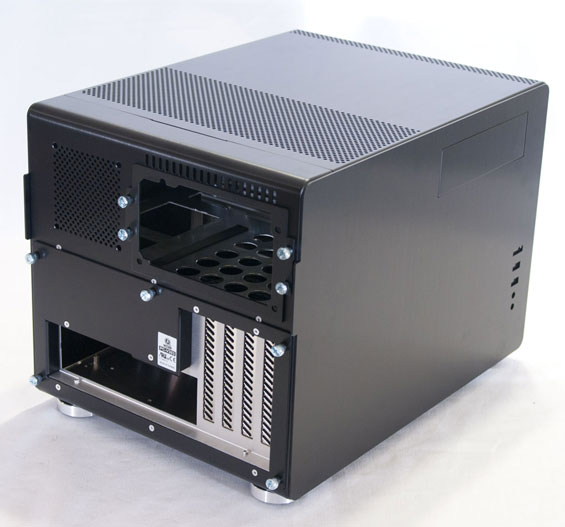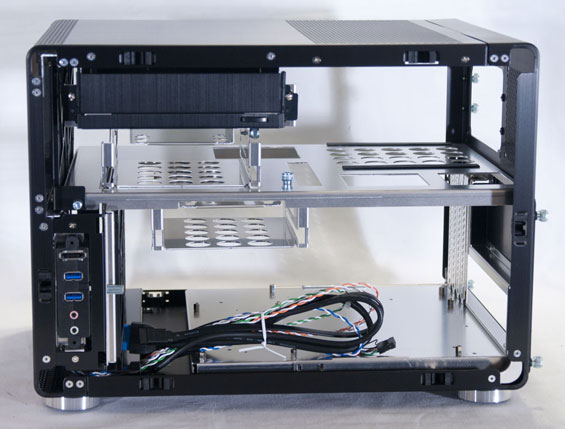Lian Li's PC-V353: Lighter Than Air
by Dustin Sklavos on September 28, 2011 4:30 AM EST- Posted in
- Cases/Cooling/PSUs
- MicroATX
- SFF
- Lian Li
- Mini-Tower
In and Around the Lian Li PC-V353
My first impression of the PC-V353 before I even opened the box was amazement: I couldn't believe just how light the case actually was. In fact I still have some trouble with it. Anyone looking for a LAN build may want to consider short-listing the PC-V353 for that reason alone; I can nearly palm the box, and I am a sad, frail, wisp of a man.
Once you get it out of the box, though, confusion is liable to set in. I'm used to cases that take a little more work to figure out, but Lian Li has gone virtually off the grid with this one. The front of the PC-V353 is entirely perforated, with only the power and reset buttons really breaking it up. Our optical drive bay is actually on the right side of the enclosure; you can opt to use the left side instead, but it would be extremely difficult to use both due to how assembly is handled (more on that later.) The ports are also on the right side, below the optical drive, and the port block can actually be removed and swapped over to the left side as well. That's made crystal clear when you look at the left side and see cutouts for the ports (shielded from behind by a plate) along with a bay shield for the 5.25" bay.

The back of the PC-V353 is home to nine thumbscrews, four of which are used for the power supply mounting bracket while the remaining five hold the removable motherboard tray in place. There are also four vented covers for the expansion slots. At this point I was wondering where the screws were to hold the side panels in place. The answer? There are none!
The side panels actually snap on and off and for what it's worth the mechanism seems pretty sturdy. It would've been easier for Lian Li to simply use screws to hold the panels in place, but I think one too many sacrifices were already made to the fit and finish of the PC-V353 by having the ports swappable between the two sides. Surprisingly, the panels feel like some of the sturdier parts of the case's design; the rest of it is so light, and the motherboard tray can actually bow.

When you do take a look at the interior of the PC-V353, it can actually seem even more puzzling: this is an instance where you're really going to want to go through the instruction manual bit by bit to be sure you know how to assemble a system within the enclosure. There's support for a grand total of five drives: one 5.25", two 3.5", and as a sign of the times, two 2.5". At first glance it also seems like you could fit a fairly long, high end video card in the PC-V353, but when we get to the assembly you'll see it doesn't really work out that way in practice.
I like how the PC-V353 looks for the most part, but I have to be honest and say it feels like they went just a little too far off the beaten path with this one. Assembling it looked frankly daunting, and in my experience smartly arranged ventilation with even a single good, quiet fan has been more effective than just venting everything. I'm also not a fan of being able to swap the optical drive and ports from the right to the left side; the result is that the side you aren't using just looks kind of unattractive and feels like there should really just be a single flat side panel. That's my personal opinion, though; your mileage may vary.
















57 Comments
View All Comments
Dustin Sklavos - Wednesday, September 28, 2011 - link
It never ceases to amaze me what some people find offensive.IlllI - Wednesday, September 28, 2011 - link
i find your post offensive!!i DEMAND you change it because i find it offensive! you have lost all credibility with me because you spoke your mind!
actually i agree. some people get too damn butt-hurt over the littlest things
JarredWalton - Wednesday, September 28, 2011 - link
+1cjmurph - Wednesday, September 28, 2011 - link
"but surprisingly they don't advertise what may be one of its more interesting aspects: the enclosure is comprised almost entirely of aluminum"Umm, it's a Lian Li case dude, what else is it going to be made out of, chicken feet?
aznofazns - Wednesday, September 28, 2011 - link
That line had me confused as well. Anyone who knows anything about Lian Li cases should realize that the all-aluminum construction is practically their main selling point.But the part that bothered me was the conclusion. "It's a nice and unique piece of aluminum, tremendously light and easy to move, but this case honestly would fare a lot better with fans." Dustin, I think you're missing the point of this case. It's designed to be a silent case, so it'd probably be wise to use a fanless PSU (Seasonic SS-400FL, anyone?), large, passively cooled CPU heatsink (or a really quiet one like the Scythe Big Shuriken or Zipang 2), and a passively cooled graphics card. Or better yet, install a Llano A8 chip.
I do agree that Lian Li didn't make the best use of space in the V353, as with most/all of the V3xx series, but the end result is a pretty slick looking microATX rig.
JarredWalton - Wednesday, September 28, 2011 - link
Having lots of ventilation (and no sound dampening) flies in the face of building a silent PC.aznofazns - Wednesday, September 28, 2011 - link
Lack of sound dampening seems irrelevant when the components inside are silent, don't you think?aznofazns - Wednesday, September 28, 2011 - link
Just to hammer this point home, read Lian Li's own description of the PC-V353:http://www.lian-li.com/v2/en/product/product06.php...
"The PC-V353 is designed to be a silent case.
To use lots vents instead of fans to cool components."
JarredWalton - Wednesday, September 28, 2011 - link
How about "quiet case" as opposed to silent, because small and compact with no sound dampening but still using a CPU fan (necessary given the cramped quarters) means that this won't be "silent".aznofazns - Wednesday, September 28, 2011 - link
Well it depends on what components you're using.For example, a low power Zacate, Llano A4, or dual core Sandy Bridge chip would be able to get by with a large, passive heatsink. The ventilated case would be enough to keep those chips from overheating. With no case fans, a fanless PSU, and an SSD, the system would literally be silent (save for possible capacitor squeal).
On the other hand, a higher power CPU/APU could use a heatsink with a large, low rpm fan. In that case it would be "quiet," but having case fans would still add to the noise.
Either way, Lian Li designed this case to be cooled passively.